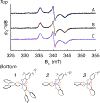Active Site Characterization of a Campylobacter jejuni Nitrate Reductase Variant Provides Insight into the Enzyme Mechanism
- PMID: 38984973
- PMCID: PMC12088371
- DOI: 10.1021/acs.inorgchem.4c01991
Active Site Characterization of a Campylobacter jejuni Nitrate Reductase Variant Provides Insight into the Enzyme Mechanism
Abstract
Mo K-edge X-ray absorption spectroscopy (XAS) is used to probe the structure of wild-type Campylobacter jejuni nitrate reductase NapA and the C176A variant. The results of extended X-ray absorption fine structure (EXAFS) experiments on wt NapA support an oxidized Mo(VI) hexacoordinate active site coordinated by a single terminal oxo donor, four sulfur atoms from two separate pyranopterin dithiolene ligands, and an additional S atom from a conserved cysteine amino acid residue. We found no evidence of a terminal sulfido ligand in wt NapA. EXAFS analysis shows the C176A active site to be a 6-coordinate structure, and this is supported by EPR studies on C176A and small molecule analogs of Mo(V) enzyme forms. The SCys is replaced by a hydroxide or water ligand in C176A, and we find no evidence of a coordinated sulfhydryl (SH) ligand. Kinetic studies show that this variant has completely lost its catalytic activity toward nitrate. Taken together, the results support a critical role for the conserved C176 in catalysis and an oxygen atom transfer mechanism for the catalytic reduction of nitrate to nitrite that does not employ a terminal sulfido ligand in the catalytic cycle.
Figures





Similar articles
-
Molecular cloning, expression and biochemical characterization of periplasmic nitrate reductase from Campylobacter jejuni.FEMS Microbiol Lett. 2018 Aug 1;365(16):fny151. doi: 10.1093/femsle/fny151. FEMS Microbiol Lett. 2018. PMID: 29931366 Free PMC article.
-
The critical role of a conserved lysine residue in periplasmic nitrate reductase catalyzed reactions.J Biol Inorg Chem. 2024 Jun;29(4):395-405. doi: 10.1007/s00775-024-02057-x. Epub 2024 May 23. J Biol Inorg Chem. 2024. PMID: 38782786 Free PMC article.
-
Models for molybdenum coordination during the catalytic cycle of periplasmic nitrate reductase from Paracoccus denitrificans derived from EPR and EXAFS spectroscopy.Biochemistry. 1999 Jul 13;38(28):9000-12. doi: 10.1021/bi990402n. Biochemistry. 1999. PMID: 10413473
-
Structural and mechanistic insights on nitrate reductases.Protein Sci. 2015 Dec;24(12):1901-11. doi: 10.1002/pro.2801. Epub 2015 Sep 22. Protein Sci. 2015. PMID: 26362109 Free PMC article. Review.
-
The O2-Evolving Complex of Photosystem II: Recent Insights from Quantum Mechanics/Molecular Mechanics (QM/MM), Extended X-ray Absorption Fine Structure (EXAFS), and Femtosecond X-ray Crystallography Data.Acc Chem Res. 2017 Jan 17;50(1):41-48. doi: 10.1021/acs.accounts.6b00405. Epub 2016 Dec 21. Acc Chem Res. 2017. PMID: 28001034 Review.
Cited by
-
In vitro sulfuration of Rhodobacter capsulatus formate dehydrogenase.J Biol Chem. 2025 Jun;301(6):108511. doi: 10.1016/j.jbc.2025.108511. Epub 2025 Apr 15. J Biol Chem. 2025. PMID: 40246024 Free PMC article.
-
Nitrate-Nitrite Interplay in the Nitrogen Biocycle.Molecules. 2025 Jul 18;30(14):3023. doi: 10.3390/molecules30143023. Molecules. 2025. PMID: 40733288 Free PMC article. Review.
-
Reversible Interconversion of Nitrate and Nitrite Catalyzed by Periplasmic Nitrate Reductase from Campylobacter jejuni.J Am Chem Soc. 2025 Apr 23;147(16):13243-13250. doi: 10.1021/jacs.4c17874. Epub 2025 Apr 9. J Am Chem Soc. 2025. PMID: 40200898
-
Insights into periplasmic nitrate reductase function under single turnover.J Biol Inorg Chem. 2024 Dec;29(7-8):811-819. doi: 10.1007/s00775-024-02087-5. Epub 2024 Dec 4. J Biol Inorg Chem. 2024. PMID: 39633165
References
-
- Hille R; Schulzke C; Kirk ML Molybdenum and Tungsten Enzymes. In RSC Metallobiology Series, Garner CD, Sun H, Wedd A, Ciurli SL, Eds.; The Royal Society of Chemistry: Cambridge, UK, 2017.
MeSH terms
Substances
Grants and funding
LinkOut - more resources
Full Text Sources
Miscellaneous

